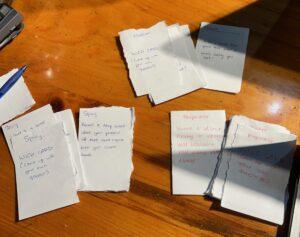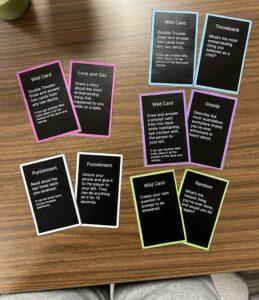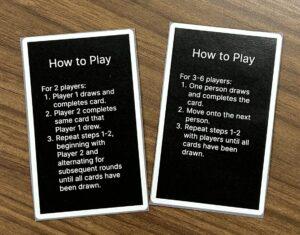Team 6: Jasmine N, Shuvi J, Ben H, Jailia Y
Artist’s Statement
In the Loop is a game designed to foster genuine connections through the sharing of secrets. While brainstorming ideas for our game, our team expressed the shared pain point of having friendships with unspoken rules or barriers. We wanted to develop a game that not only entertained, but also facilitated meaningful conversations.
In the Loop does exactly that, in the form of a getting-to-know-you game. Upon opening the box, you will be greeted with five decks of cards, four of which contain categorized prompt cards, and the last containing punishment cards. Players take turns selecting a prompt card and answering it, otherwise taking a punishment card as an easy opt-out. On each turn, secrets will be shared and connections will deepen.
We wanted our game to be engaging and inclusive to different relationship levels, so we added “wild cards” and “punishment cards” to our game. On each turn, there is a chance to draw a “wild card,” which adds unexpected constraints to the game, and players are also able to easily opt-out of answering a prompt by drawing a “punishment card.”
In the Loop is a game born from our desire to create and foster deeper connections. We hope that players will end the game by breaking down the unspoken barriers that come with friendships.
Concept Map

Initial Decisions
In the Loop is a prompt-based card game designed to encourage players to reveal their secrets. However, its inception was rooted in the social deduction genre, drawing inspiration from games like Mafia and One Night Ultimate Werewolf, which we played in class and during our critical plays. During the ideation stage, our team expressed the shared pain point of having friendships with unspoken rules regarding what is appropriate to discuss with one another; these unspoken rules are a barrier to developing deeper relationships. We saw an opportunity to break these barriers by developing a game that not only entertained but facilitated meaningful conversations.
Originally called Cloak & Whispers: The Secret Sharing Game, our initial concept mirrored the mechanics of social deduction games. It targeted groups of at least three players that already knew each other and were hoping to build closer relationships. Players would have access to the game cards, as well as writing utensils and paper. This is the gameplay procedure we envisioned:
- One player draws and reads a prompt card.
- All players anonymously write down their responses to the prompt.
- The responses are shuffled.
- The responses are revealed and players try to match the responses to the players they believe wrote then.
Like in Mafia and One-Night, in the matching phase of Cloak & Whispers, players could bluff in order to avoid having their response be correctly matched to them. Our goal was to drive conversation through these basic mechanics. For instance, players would ideally engage in conversation about the stories behind their responses, or explanations as to why certain responses were not written by them.
However, unlike traditional social deduction games where the objective is to uncover hidden roles, the primary objective of Cloak & Whispers was to encourage players to engage in conversation that transcended the game; conversations about personal experiences and stories that they typically would not share. In this vein, we wanted to develop a game that created dynamics of information sharing and collaboration between players. In addition, we hoped the game would create a space of inclusivity, where all players would feel comfortable sharing their responses and embracing the vulnerability of having their responses revealed.
When designing Cloak & Whispers, we wanted players to achieve the outcomes of satisfaction with their gameplay and feelings of closeness with the other players. In reaching these outcomes, we hoped that players had the opportunity to engage in meaningful conversations about topics they normally would not discuss together. Players were only bound by their internal limits, but we hoped players would be able to break these boundaries as they formed closer connections.
Testing and Iteration History
We conducted a total of four playtests, with most playtests occurring among 3-4 players, and one occurring among 6 players.
Before our initial playtest, we originally intended for the game to be a social deduction game that primarily revolved around guessing the secrets of the other players in the game. We knew this concept had a plethora of issues involving the logistics of matching and player comfortability, so we decided to playtest the game as a getting-to-know-you style card game.
During the first playtest with other 247G students, we played the most basic version of the game, which included three decks of questions that were categorized into “easy,” “medium,” and “spicy.” This playtest had four players, three of whom knew each other prior to the playtest. A player would pick a card from a deck of their choosing, and everyone would share according to the prompt on the card. This playtest revealed a few issues with this version of the game – players enjoyed the spicy questions, but felt that the medium or easy questions felt a little too serious and existential for the tone of the game. This revealed that not only had we miscategorized some of the questions as medium or easy, which threw off the pacing of the game, but we also had questions that felt inconsistent with the overall feel of the game.

When we witnessed how the tone shift made players uncomfortable, we decided to revise all questions of the game to be lighthearted, and remove any cards that got at extremely vulnerable secrets (ex. Reveal a secret that has fundamentally changed who you are). The playtesters from this iteration of the game also suggested that they’d also want to share secrets that were not about them, which we also integrated into some of the questions. We also ensured that the categories were accurate, and that the secrets demanded from each card reflected the card’s level of easy, medium, or hard.
The second playtest was hosted among friends of every group member. At this point, the game looked very similar to the way it looked before, but with the revised questions. This playtest included 4 players, none of whom knew each other prior to the play test. The game went very smoothly this playtest – players gave feedback that they authentically enjoyed the game. However, players felt that the game dragged a little too long when players could not think of a secret during their turn, and that, when this inevitably happened as every player answered every card, the game began to feel monotonous.
This led us to implement wild cards, and do away with the easy, medium, and spicy categories. We replaced the categories with gossip, throwback, sex and love, and random, so that players could choose from the categories about which they felt they had the most to share. We wanted this change to prevent some of the long awkward pauses when a player felt they had nothing to share as a response to the card they pulled. We also wanted this to help with the pacing of the game, so that players that knew each other better didn’t feel like the game was over once the hard pile was finished. With the wild cards, we wanted to break up the game, because we did feel like the constant stream of q and a began to feel repetitive after a few questions. These wild cards included making constant eye contact with the person to your right, drawing double cards, or creating your own prompt for the rest of the players to answer.

This version of our game was played in the third playtest of our game. This time, we had 6 players, which included 2 pairs of friends with the rest of the participants not knowing one another. Each player was asked to draw one card and one wild card, and each player would have to answer to that card with the additional demand of the wild card. Given the higher number of players in this playtest, we felt that each round went on much longer than anticipated, and there were more moments of silence as each player had to think about their answer than before. We did not feel that the wild card addition worked well during this playtest, as some of the wildcards did not make sense with the original card pulled, and each player that went after the player whose turn it was seemed to forget the addition of the wild card altogether. This kept making the game feel choppy, so we eventually allowed players to play without pulling a wild card at their request. We did get the feedback that the questions and categories were both strong and entertaining, so we decided to stop iterating our decks of prompts.
In preparation for the final playtest, we decided to integrate the wild cards into the decks to ensure that they would correspond to the original cards pulled, and have only the player whose turn it was to choose a card actually answer said card. We made sure that each wild card could work with each card in the deck that it belonged to, so that there were no awkward pauses as a player decided that their wild card did not work. We also decided making every player answer every card made the game feel too long and uninteresting, and quickening the pace would help with some of the player fatigue as the game progresses. It also better preserved the player autonomy, as each player could guarantee that they’d only be asked to share secrets in categories of their choosing. We hoped that this increase in player autonomy could help with some of the inherent discomfort of sharing one’s secrets, regardless of whether the game was being played amongst friends or strangers.
With our changes, our final playtest went more smoothly than any playtest we had conducted before. The playtest consisted of three people, 2 of whom knew each other and one of whom did not. Each player picking a card and answering it made the game’s pace feel a lot better and less drawn out. The implementation of wild cards was a fun addition that kept each round unique and exciting. We got the feedback that the game felt fun and thrilling, and that players felt more ready to choose from more vulnerable categories like love and sex as the game went on. This is exactly the tone we wanted for the game – we wanted players that were eager to share about themselves and to know more about their fellow players, all accomplished in the language of secrets.
Final Playtest
Final Prototype



Link to final box design: In-The-Loop_Box_Design.pdf
Print-n-Play
Link to print-n-play: In-The-Loop_PrintNPlay.pdf




